|
|
 |
|
Calanoida ( Order ) |
|
|
|
Clausocalanoidea ( Superfamily ) |
|
|
|
Aetideidae ( Family ) |
|
|
|
Gaetanus ( Genus ) |
|
|
| |
Gaetanus armiger Giesbrecht, 1888 (F,M) | |
| | | | | | | Syn.: | Aetidius armiger : T. Scott, 1894 b (p.71);
? G. atlanticus Wolfenden, 1904 (p.132); Jespersen, 1934 (p.61, Rem.);
no G. armiger : Davis, 1949 (p.28, figs.F); Tanaka, 1969 (p.257, figs.M) | | | | Ref.: | | | Giesbrecht, 1892 (p.219, 224, figs.F); Giesbrecht & Schmeil, 1898 (p.33); A. Scott, 1909 (p.45, figs.F, Rem.); Sars, 1925 (p.59, figs.F); Sewell, 1929 (p.101); Mori, 1937 (1964) (p.40, figs.F, Rem.); Lysholm & al., 1945 (p.16); Sewell, 1947 (p.56, 58); Vervoort, 1952 e (n°46, p.3, figs.F); Tanaka, 1957 b (p.172, figs.F); Vervoort, 1963 b (p.129, Rem.); Tanaka & Omori, 1970 (p.133); Morris, 1970 (p.2304: Rem.); Park, 1975 a (p.27, Descr.M, figs.F,M); Bradford & Jillett, 1980 (p.48); Roe, 1984 (p.357); Markhaseva, 1996 (p.180, figs.F,M); Chihara & Murano, 1997 (p.687, Pl.42,44: F,M); Vives & Shmeleva, 2007 (p.589, figs.F,M, Rem.) |  issued from : T. Park in Bull. Mar. Sci., 1975, 25 (1). [p.27, Fig.10]. Female: A, posterior part of metasome and urosome (lateral); B, forehead (lateral); C, rostrum (anterior); D, A2; E, coxa of Mxp; F, first leg (anterior); G, coxa of fourth leg (partial, posterior).
|
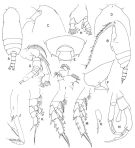 issued from : T. Park in Bull. Mar. Sci., 1975, 25 (1). [p.28, Fig.11]. Male: A, B, habitus (dorsal and lateral, respectively); C, D, forehead (lateral, dorsal); E, F, last metasomal and genital segments (dorsal, lateral); G, A2; H, mandibular palp; I, Mx1; J, Mxp; K, P1; L, P2; M, P3; N, fifth pair of legs (posterior); O, last two exopodal segments of left fifth leg (medial). P1-3: legs (anterior).
|
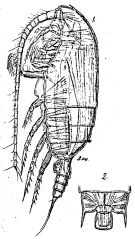 Issued from: G.O. Sars in Résult. Camp. Scient. Prince Albert I, 69, pls.1-127 (1924). [Pl.XVIII, figs.1-2]. Female: 1, habitus (lateral left side); 2, posterior part cephalothorax.
|
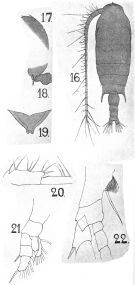 issued from : A. Scott in Siboga-Expedition, 1909, XIX a. [Plate VIII, Figs.16-22]. Female (from Indonesia-Malaysia): 16, habitus (dorsal); 17, forehead (lateral); 18, last thoracic and genital segments (left side); 19, rostrum; 20, Mxp (basal portion only); 21, P1: 22, P4 (basal portion only). Nota: Apparent absence of the lamella on the basal segment of Mxp, as it is evidently vry small and will, therefore, be easily folded up.
|
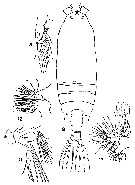 issued from : T. Mori in The pelagic Copepoda from the neighbouring waters of Japan, 1937 (2nd edit., 1964). [Pl.17, Figs.8-13]. Female: 8, P1; 9, habitus (dorsal); 10, P4 (posterior); 11, A2; 12, Mx2; 13, Mx1.
|
 issued from : C.C. Davis in Univ. Wash. Publs Biol., 1949, 14. [Pl.3, Figs.30-32]. Female (from NE Pacific): 30, forehead (lateral); 31, last thoracic segment and urosome (lateral); 32, 1st basal segment of Mxp. Nota : Frontal spine small and turned downwards nearly parallel to the front. Rostrum small, consists of but a single point. A1 24-segmented, extending about to the genital segment. Head and 1st thoracc segment fused, 4th and 5th segments fused. Soines on the posterior corners of prosome about ¾ the length of the genital segment. Urosomal sents 2, 3 and anal of about equal lengths ; genital segment about as long as the 2nd and 3rd segments combined. Mxp without trace of a lamella or protrusion on the 1st basal segment.
|
 Issued from : W. Giesbrecht in Systematik und Faunistik der Pelagischen Copepoden des Golfes von Neapel und der angrenzenden Meeres-Abschnitte. – Fauna Flora Golf. Neapel, 1892. Atlas von 54 Tafeln. [Taf. 14 , Figs.19, 20 ]. Female: 19, A2 (anterior view); 20, Md (mandibular palp; posterior view).
|
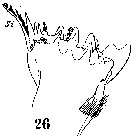 Issued from : W. Giesbrecht in Systematik und Faunistik der Pelagischen Copepoden des Golfes von Neapel und der angrenzenden Meeres-Abschnitte. – Fauna Flora Golf. Neapel, 1892. Atlas von 54 Tafeln. [Taf. 14, Fig.26 ]. Female: 26, Md (cutting edge).
|
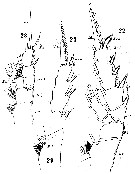 Issued from : W. Giesbrecht in Systematik und Faunistik der Pelagischen Copepoden des Golfes von Neapel und der angrenzenden Meeres-Abschnitte. – Fauna Flora Golf. Neapel, 1892. Atlas von 54 Tafeln. [Taf. 14, Figs.22, 23, 28, 29 ]. Female: 22, P2 (posterior view); 23, exopod 3 of P4 (posterior view); 28, P1 (anterior view); 29, basipod 1 of P4.
|
 Issued from : W. Giesbrecht in Systematik und Faunistik der Pelagischen Copepoden des Golfes von Neapel und der angrenzenden Meeres-Abschnitte. – Fauna Flora Golf. Neapel, 1892. Atlas von 54 Tafeln. [Taf. 36 , Figs.2, 4, 5]. Female: 2, habitus (lateral); 4, urosome (ventral); 5, forehead (lateral).
|
 Gaetanus armiger Gaetanus armiger female: 1 - Anterior part of cephalon with frontal spine. 2 - Exopodal segment 1 of A2 without seta; exopodal segment 2 with 2 setae (1 medial situated on conic protrusion and 1 distal). 2nd internal lobe of Mx1 with 4 setae. Exopod of P1 always with 2 external spines. 3 - Mxp protopodite without lateral plate. 4 - Exopod of P1 evidently 3-segmented.
|
 Gaetanus armiger Gaetanus armiger male: 1 - Cephalon with frontal spine. 2 - Exopodal segment 3 of left P5 prolonged, stylet-like, never bilobated. It is always longer than exopodal segment 2. 3 - Frontal spine removed from anterior part of cephalon dorsally (lateral view), poorly visible.
|
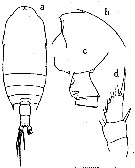 issued from : Tanaka O. in Publ. Seto Mar. Biol. Lab., 1957, 6 (2). [p.172, Fig.42, a-d]. Female (from Sagami): a, habitus (dorsal); b, forehead (lateral); c, last thoracic segment and genital segment (lareral); d, exopodite of P1. Nota Female: - Cephalothorax about 3.49 times the abdomen length (2.62 : 0.75). - Cephalic spine slender and short, directing forwards. - Rostrum small. - Last thoracic segment with lateral spines divergent, and extend beyond the middle of genital segment. - Articulation between 4th and 5th thoracic segments slightly visible in dorsal view. - Abdomen 4-segmented; segments and caudal rami with proportional lengths 52 : 22 : 19 : 15 : 22 = 100. - Genital segment as long as wide. - Caudal rami about 1.2 times aés long as wide. - A1 23-segmented. - A2 exopod 1.2 times as long as endopod.. - Mxp without lamellous process on the distal margin of 1st basal segment.. - Terminal spine of exopod of P2 to P4 with 18, 18 and 27 teeth respectively. - P4 bears 17 spines on inner margin of coxa at the base of inner marginal seta.
|
 issued from : Tanaka O. in Publ. Seto Mar. Biol. Lab., 1957, 6 (2). [p.172]. Female A1: proportional lengths of segments. - A1 23-segmented, extends to distal end of 3rd abdominal segment; segments 24-25 are 1.05 times as long as segment 19; according to Giesbrecht, segments 22 and 23 of equal lengths, but in the present specimenn segment 22 is 1.1 times as long as the 23rd.
| | | | | Compl. Ref.: | | | Cleve, 1904 a (p.191); Pearson, 1906 (p.14); Wilson, 1942 a (p.187); Sewell, 1948 (p.347, 499, 516, 519, 520, 545, 556, 566); ? C.B. Wilson, 1950 (p.229); Chiba & al., 1957 (p.308); Minoda, 1958 (p.253, Table 1, 2, abundance); Fagetti, 1962 (p.18); Furuhashi, 1966 a (p.295, vertical distribution in Oyashio/Kuroshio transitional area, Table 7, 10); Grice & Hulsemann, 1967 (p.15); Shih & al., 1971 (p.143); Roe, 1972 (p.302, 308); Deevey & Brooks, 1977 (p.256, Table 2, station "S"); Vives, 1982 (p.291); Roe, 1984 (p.357); Madhupratap & Haridas, 1986 (p.105, tab.1); Lozano Soldevilla & al., 1988 (p.58); Park & Choi, 1997 (Appendix); Suarez-Morales & Gasca, 1998 a (p108); Lapernat, 2000 (tabl.3, 4); Holmes, 2001 (p.48); Fernandes, 2008 (p.465, Tabl.2 as arminger); Galbraith, 2009 (pers. comm.); C.E. Morales & al., 2010 (p.158, Table 1); in CalCOFI regional list (MDO, Nov. 2013; M. Ohman, comm. pers.); Hirai & al., 2013 (p.1, Table I, molecular marker) | | | | NZ: | 16 | | |
|
Distribution map of Gaetanus armiger by geographical zones
|
| | | | | | | | | | | | | Loc: | | | South Africa, Atlant. (tropical), G. of Guinea, off NW Cape Verde Is., off NW Canary Is., off W Cabo Finisterre, off Azores, G. of Mexico, Sargasso Sea, off Bermuda: Station "S" (32°10'N, 64°30'W), ? S Davis Strait, Norwegian Sea, Faroe Is., Iceland, off W Ireland, North Sea, Indian, off E Sri Lanka, Bay of Bengal, Indonesia-Malaysia, China Seas (East China Sea), S Korea, Japan (Izu), ? Bering Sea, Pacif. (NE & SW), off Vancouver Is., off California, W Baja California, Hawaii, off Malpelo Is., off Galapagos, off Peru, off Chile (., Concepcion).
Type locality: Pacific (equatorial). | | | | N: | 46 | | | | Lg.: | | | (1) F: 3; (5) F: 3,5; (14) F: 3,05-2,95; (37) F: 4,7-2,7; M: 3,16-2,6; (40) F: 3,6-2,72; M: 3,16-2,6; (46) F: 3,2; ? (49) F: 4,7-4,5; (56) F: 3,37; (57) F: 2,6; (59) F: 4,7-3; (113) F: 3,2; (199) F: 3,12; (866) M: 3,1; {F: 2,60-4,70; M: 2,60-3,16} | | | | Rem.: | épi-bathypelagic-?. 1500-2000 m in Sargasso Sea (Deevey & Brooks, 1977, Station "S"). 298-526 m at Station N-1 (SW Bösö, E middle Japan) from Furuhashi (1966 a).
The synonymy of G. atlanticus with this species like that of Aetidius armiger in T. Scott (1894 b, is questioned by Vervoort (1963 b, p.129-130). If G. atlanticus is well conspecific with G. armiger, the variability in length in G. armiger is very wide (females: 2.70-4.70 mm) and the endopodite of P1 may be either 2- or 3- segmented. Brodsky (1950, p.163)) has separated the North Pacific specimen as G. simplex; in this species the endopodite of P1 is 2-segmented, and the body lengths are 3.20 mm in female and 3.10 mm in male, as appears G. armiger has also been recorded from the Northwestern Pacific.
According to Morris (1970), certain confusions have been possible between this species and Gaetanus simplex. According to Morris it appears that G. simplex inhabits the cold waters north of the subarctic boundary, and the closely related G. armiger occurs in the warmer waters to the south.
To Park (1975, p.36), the records from the northern North Pacific are questionable, for the species has often been confused with G. campbellae (= G. intermedius) = G. simplex. | | | Last update : 11/04/2017 | |
|
|
 Any use of this site for a publication will be mentioned with the following reference : Any use of this site for a publication will be mentioned with the following reference :
Razouls C., Desreumaux N., Kouwenberg J. and de Bovée F., 2005-2025. - Biodiversity of Marine Planktonic Copepods (morphology, geographical distribution and biological data). Sorbonne University, CNRS. Available at http://copepodes.obs-banyuls.fr/en [Accessed August 17, 2025] © copyright 2005-2025 Sorbonne University, CNRS
|
|
 |
 |













